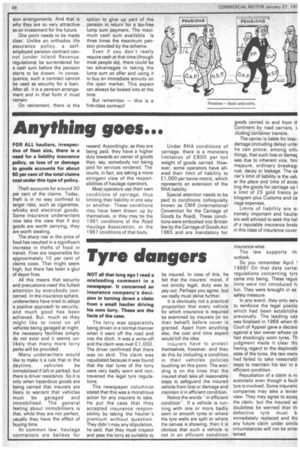Anything goes...
Page 50

If you've noticed an error in this article please click here to report it so we can fix it.
FOR ALL hauliers, irrespective of fleet size, there is a need for a liability insurance policy, as loss of or damage to goods accounts for about 60 per cent of the total claims cost under this type of policy.
Theft accounts for around 30 per cent of the claims. Today, theft is in no way confined to target risks, such as cigarettes, whisky and electrical goods. Some insurance underwriters now take the view that if any goods are worth carrying, they are worth stealing.
The sharp rise in the price of food has resulted in a significant increase in thefts of food in transit. Fires are responsible for approximately 10 per cent of claims costs. That might seem high, but there has been a glut of depot fires.
All this means that security and precuations need the fullest attention by everybody concerned. In the insurance sphere, underwriters have tried to adopt a positive approach to security, and much good has been achieved. But, much as they might like to insist on all vehicles being garaged at night, the necessary facilities simply do not exist and it seems unlikely that many more lorry parks will be provided.
Many underwriters would like to make it a rule that in the daytime, vehicles be immobilised if left or parked, but there is driver resistance. So it is only when hazardous goods are being carried that insurers are likely to warrant that vehicles must be garaged and immobilised. The general feeling about immobilisers is that, while they are not perfect, usually they have the effect of buying time.
At common law, haulage contractors are bailees for reward. Accordingly, as they are being paid, they have a higher duty towards an owner of goods than, say, somebody not being paid for services rendered. The courts, in fact, are taking a more stringent view of the responsibilities of haulage operators.
Most operators use their own conditions of carriage, thus limiting their liability in one way or another. These conditions may have been drawn up by themselves, or they may be the 1961 conditions of the Road Haulage Association, or the 1967 conditions of that body. Under RHA conditions of carriage, there is a monetary !Imitation of £800 per ton weight of goods carried. However, some operators have altered their limit of liability to £1,000 per tonne metric, which represents an extension of the RHA liability.
Special attention needs to be paid to conditions colloquially known as CMR (international Convention for the Carriage of Goods by Road). These conditions were embodied into British law by the Carriage of Goods Act 1965 and are mandatory for goods carried to and from t' Continent by road carriers, cluding container transits.
The carrier is liable for loss damage (including delay) unle: he can prove, among othi things, that such loss or dama€ was due to inherent vice, for majeure, ordinary breakagi rust, decay or leakage. The ca rier's limit of liability is the valt at the place and time of accei ting the goods for carriage up 1 a limit of 25 gold francs pE kilogram plus Customs and ca riage expenses.
Limits of liability are e; tremely important and hauliei are well advised to seek the hel of a reputable insurance brok( in this class of insurance cover




















































































































